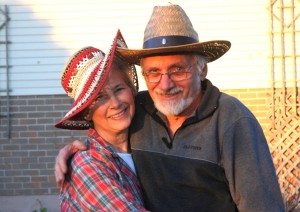 Thank you Sheila Ellis, who took and contributed a photo of Jim and Sheila’s granddaughter Chelsea. Second photo from the left, page 37. Below is their story, written by Jim. Jim has contributed countless times to my Facebook page, educating me and others, thereby enhancing the quality of my book.
Thank you Sheila Ellis, who took and contributed a photo of Jim and Sheila’s granddaughter Chelsea. Second photo from the left, page 37. Below is their story, written by Jim. Jim has contributed countless times to my Facebook page, educating me and others, thereby enhancing the quality of my book.
My early academic training was as a zoologist (parasitology), so I was familiar with basic biological phenomena when, in the summer of 1977, while vacationing on Lake Joseph, near Mactier, I found several Monarch larvae on some common milkweed, and brought them into the cottage to the delight of our two children who were 5 and 7 at the time. When we returned to Welland that summer we brought a number of larvae and pupae with us. Excitement reigned a few days later as we cheered the arrival of several new adults, which fluttered around our kitchen before being released into the wild.
Every summer since, (for the last 37 years) we have reared and released Monarchs as part of our summer tradition, in which for many years, my dad was also a keen participant.
Then in 1997 Sheila (my wife) and I began tagging Monarchs through Monarch Watch. Our first recovery in 1999 was one of those once in a life time events, accompanied by jubilation and tears. In the intervening years since then, another 61 have carried one of our tags to the wintering grounds in Mexico, another was found in Kentucky, and 5 others here in Ontario.
We also had the immense privilege of visiting the El Rosario Sanctuary in 2004, where we were surrounded by the clouds of Monarchs like those which we had seen on TV. It was an almost unbelievable dream to actually be there in person, truly a sacred moment for us. Carole Jordan met us at Quinta Mitzi’s Motel near Tuxpan, where we were able to listen to Mitzi’s stories of the early days of the Monarch discoveries, and of some of the researchers who stayed at this same motel, and slept in the same beds in which we were now sleeping. We ate lunch on the lawn in front of the unit where Fred and Nora Urquhart stayed in those heady years in the 70’s when the nearby annual destination was being discovered.
The Monarch experience has been part of our grandchildren’s lives (now 8 and 9) while they were still in their high chairs. Every year since they began kindergarten, we have taken Monarch larvae, pupae, and adults into classrooms in their schools, giving students in several classes opportunities to have larvae crawl on their fingers, learn about milkweed, nectaring flowers, and environmental concerns. Their experience of releasing tagged Monarchs in the school yard, waving goodbye and wishing them well on their long journey to Mexico is always accompanied by broad smiles and excited facial expressions, often shared by their grateful teachers. The picture of Chelsea with a male Monarch on her finger was taken in our back yard in Oshawa. He had eclosed recently and we were admiring him while we waited for him to take his first flight. The delight on Chelsea’s face is indicative of her enjoyment.
Their school has also developed a butterfly garden to which we have contributed some time, energy, and ideas. They plan to apply for Way Station status.
We have also shared the Monarch story with church groups and seniors’ residences and provided larvae and pupae to our dentist and chiropractor offices. Many of our friends’ children have been recipients of our larvae or pupae which has allowed them to observe pupation and eclosure, introducing them to the Monarch story and the wonder which exists in nature, as well as the sense of awe engendered within.
Since we semi-retired in 2006, we have been able to invest more time and energy into this venture, and usually tag over 1000 adults in Ontario during the migration. It also means many hours among the wildflowers, various other plants and animals, fall colors, and the rhythmic sounds of waves caressing the northern shores of Lake Ontario. Sheila and I feel enlivened and grateful for each moment, including those when strangers stop and ask us what we are up to! It has also provided numerous wonderful opportunities to enjoy another passion, nature photography.
Being part of the Monarch Health Project, contributing to the annual survey of the prevalence of Ophryocystis elektroscirrha (OE) the obligate, protozoan parasite of Monarchs, provides a further opportunity to contribute to the well-being of this amazing insect.
From their arrival every late May/early June, until the last one disappears in October, Monarchs are an integral part of the annual rhythm of our lives. We hope to share the journeys of these amazing insects for many years to come, and help to secure this magnificent migration for the enjoyment of many future generations.